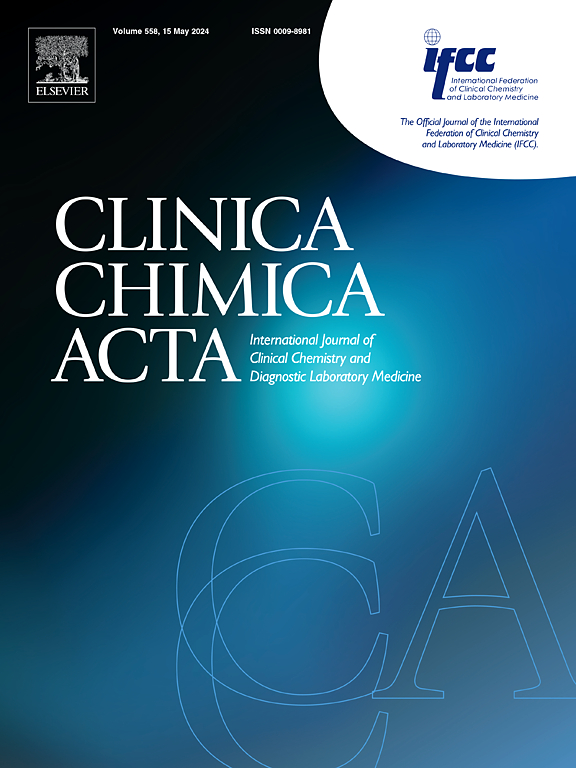Soluble oncostatin M receptor (sOSMR): A potential biomarker in systemic sclerosis diagnosis
IF 3.2
3区 医学
Q2 MEDICAL LABORATORY TECHNOLOGY
引用次数: 0
Abstract
Background
Systemic sclerosis (SSc) is a complex disease whose diagnosis is based on clinical manifestations, serological testing for autoantibodies, and nailfold capillaroscopy. Although some proteins have been proposed as biomarkers, the diagnosis of SSc remains a challenge for clinicians. The soluble oncostatin M receptor (sOSMR) is a potential biomarker for the diagnosis of SSc, as it appears to act as an antagonist of oncostatin M (OSM)-mediated signaling, which is involved in biological and inflammatory processes, including tissue injury and fibrosis. Therefore, this study aimed to evaluate the diagnostic performance of sOSMR in systemic sclerosis.
Methodology
Serum samples were collected from 105 patients with SSc, 50 with rheumatoid arthritis (RA), 64 with systemic lupus erythematosus (SLE), and 130 healthy controls (HC). The sOSMR levels were measured using an ELISA kit, and a receiver operating characteristic (ROC) curve was used to analyze the biomarker’s potential for diagnosing SSc.
Results
sOSMR levels are significantly elevated in the serum of patients with SSc when compared to patients with RA and SLE, as well as healthy controls (p < 0.0001 for all comparisons). The area under the curve (AUC) of ROC curve analysis revealed the ability of sOSMR serum levels to distinguish patients with SSc from those with RA (0.901 [95 % CI 0.842–0.943]; p < 0.0001), with a sensitivity of 89.52 % and specificity of 78.00 %, and from patients with SLE (0.897 [95 % CI 0.841–0.938]; p < 0.0001), with a sensitivity of 81.90 % and specificity of 89.06 %, as well as from healthy controls (0.876 [95 % CI 0.827 – 0.916]; p < 0.0001), with a sensitivity of 82.86 % and specificity of 81.54 %. When comparing patients with SSc to patients with other diseases (RA and SLE combined), an AUC of 0.898 ([95 % CI 0.851–0.935]; p < 0.0001) was found, with a sensitivity of 82.86 % and specificity of 85.09 %.
Conclusion
Serum sOSMR levels are elevated in patients with SSc and have shown a good ability to distinguish between SSc patients, patients with other autoimmune rheumatologic diseases (RA and SLE), and healthy controls. Thus, sOSMR is a promising marker for diagnosing SSc.
求助全文
约1分钟内获得全文
求助全文
来源期刊

Clinica Chimica Acta
医学-医学实验技术
CiteScore
10.10
自引率
2.00%
发文量
1268
审稿时长
23 days
期刊介绍:
The Official Journal of the International Federation of Clinical Chemistry and Laboratory Medicine (IFCC)
Clinica Chimica Acta is a high-quality journal which publishes original Research Communications in the field of clinical chemistry and laboratory medicine, defined as the diagnostic application of chemistry, biochemistry, immunochemistry, biochemical aspects of hematology, toxicology, and molecular biology to the study of human disease in body fluids and cells.
The objective of the journal is to publish novel information leading to a better understanding of biological mechanisms of human diseases, their prevention, diagnosis, and patient management. Reports of an applied clinical character are also welcome. Papers concerned with normal metabolic processes or with constituents of normal cells or body fluids, such as reports of experimental or clinical studies in animals, are only considered when they are clearly and directly relevant to human disease. Evaluation of commercial products have a low priority for publication, unless they are novel or represent a technological breakthrough. Studies dealing with effects of drugs and natural products and studies dealing with the redox status in various diseases are not within the journal''s scope. Development and evaluation of novel analytical methodologies where applicable to diagnostic clinical chemistry and laboratory medicine, including point-of-care testing, and topics on laboratory management and informatics will also be considered. Studies focused on emerging diagnostic technologies and (big) data analysis procedures including digitalization, mobile Health, and artificial Intelligence applied to Laboratory Medicine are also of interest.
 求助内容:
求助内容: 应助结果提醒方式:
应助结果提醒方式:


